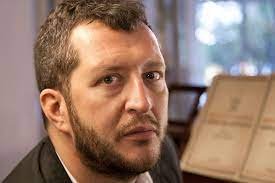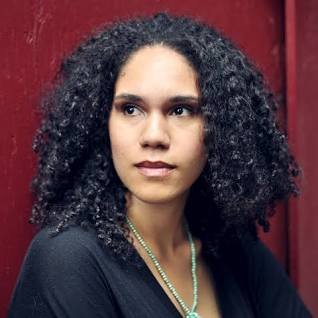Program Notes
by performance time
2-2:20pm
Jessica Meyer is an award-winning composer and violist living in New York City who draws on an array of styles – from traditional classical to Indian raga and Appalachian fiddling – to express her own unique compositional voice. About her work for violin and viola titled Only a beginning, Meyer writes:
Only a beginning was inspired by words and music I interacted with during the Summer of 2015. The title comes from Indira Ghandi’s quote: “Martyrdom does not end something, it is only a beginning.” I happen to stumble upon this quote after a week of performing Poulenc’s “Dialogues of the Carmelites” at Caramoor and a chance encounter of hearing a friend sing the “In Paradisum” of the standard Catholic Funeral mass. With all of these events coinciding, I could not help but reflect on what sacrifice means – what we think it means, and how it actually plays out in everyday life. We may sacrifice things for God, our spouse, our children, our family, our friends, sometimes even for people we don’t even know. This piece explores what can happen to us emotionally in this act of giving, and what we ultimately learn about ourselves in the process.
Chris Cerrone is a GRAMMY-nominated composer who often utilizes electronics to enhance the timbres, colors and expression of his music. The work on this program, however, is purely acoustic. About this haunting work area of refuge, Cerrone writes: Living for the past month in a hotel in Pittsburgh, Pennsylvania, I kept seeing signs for an area of refuge—a legally mandated location where people can gather in times of emergency. Repeatedly seeing these signs transported me back to a small corner waiting area in the hospital where I recently spent the days waiting on my father during the last days of his life. The space seemed to symbolize a kind of limbo, a place of waiting, and pain, but also refuge. The emotions in my piece reflect this state—suspended, emotionally unclear, and without resolution. [Chris Cerrone includes the following quote as inspiration]: “As in a dream, there is no release until we wake up, and not because the dream has ended.” — Morton Feldman, note to The Viola in My Life
Thomas Adès is one of Britain’s most renowned composers. His epic, four-movement work for cello and piano Lieux retrouvés (places rediscovered) is inspired in part by one of his favorite writers, Marcel Proust. With each movement stirring up a profound sense of place, Adès begins with the gently rippling Les Eaux, featured on this program. About this movement, Adès himself writes: The movement of the waters is recreated in flexible fluid counterpoint which eddies and flows according to how each line responds to the other current, whether in similar forward motion or opposition, or swirling around, or inside, an obstacle.
2:20-2:50pm
Spanish-born cellist and composer Andrea Casarrubios is a well-known performer who has recently gained acclaim for her compositions. About her work for solo violin entitled Amid a Place of Stone, Casarrubios simply writes: This piece, conceived during the 2020 pandemic and the ensuing crisis in the performing arts, combines nocturne and passacaglia elements, and traverses a range of phases within the subjects of isolation, vulnerability, and survival.
Jessie Montgomery is an award-winning composer and violinist whose music interweaves classical music with elements of vernacular music, improvisation, poetry, and social consciousness, making her an acute interpreter of 21st-century American sound and experience. About her work Peace for viola and piano, Montgomery writes:
Written just a month after the Great Sadness of the first quarantine orders due to COVID-19, facing the shock felt by the whole globe as well as personal crisis, I find myself struggling to define what actually brings me joy. And I’m at a stage of making peace with sadness as it comes and goes like any other emotion. I’m learning to observe sadness for the first time not as a negative emotion, but as a necessary dynamic to the human experience.
Returning to Andrea Casarrubios, this part of the program concludes with her La Libertad se levantó llorando for violin, cello, and pre-recorded text. As Casarrubios describes:
The text is part of a poem by Pablo Neruda, an excerpt that refers to the Spanish Civil War. The music is filled with the strength and the vulnerability of Neruda's words. In this piece, the image of battered Liberty is used to resonate with our own perceptions of the never-ending global fight for human rights.
2:50-3:10PM
In addition to repeat performances of Chris Cerrone’s area of refuge and Thomas Adès’ Lieux retrouvés described above, this section of the program also features the violin and piano duo Be There by New York City-based composer Judd Greenstein. About this reflective, minimal work, Greenstein writes:
Be There is a continuation of my effort to strip down my musical language to its essential components, to be fluid and Romantic and gestural and rhythmic all at the same time, without calling undue attention to those features or qualities. When I am writing music, and things are going well, I feel that I am present in the moment of the music’s creation, a present-ness that is more full than any other I know. To “be there” is the best state that there is; it’s the state of complete association with life and living, an association that is the utter antidote to the dissociative forces of anxiety and fear. Whether Be There expresses that idea to other listeners, fully, partially, or not at all, it somehow conveys that meaning to me.
2:50-3:05PM
Outside, near Ruby City’s magnificent garden sculpture, you can hear Jessica Meyer’s work for solo viola and loop pedal titled Getting Home (I must be…). About this virtuosic work for the viola, Meyer writes:
I wrote most of this piece on a plane. I was traveling a lot, and on this particular flight from the west coast, I had a wave of anxiety pass over me as the plane took off because I really wanted to go home and get to my son Ethan. For some reason, along with that feeling came a particular rhythm in my head that wound up being the pizzicato riff that drives the first half of this piece. Thankfully I didn’t have any devices to distract myself with or have a TV on the back of the seat in front of me ….so I grabbed my Expedia itinerary, flipped it over and started writing it out. Creative ideas are like balls – you have to make the time to be ready to catch them as they are being thrown at you. This piece is for my son Ethan, who knows all too well the work it takes to catch these balls -but also sees the joy of someone doing something they love.
3:10-3:20PM
Pulitzer Prize-winning composer Caroline Shaw understands how to play with sound and its infinite textures. As a member of the GRAMMY-winning, contemporary vocal group Roomful of Teeth, she often draws on the unique, raw capabilities of the human voice. When turning to instruments, she mines their intrinsic timbrel powers for expression: from violent pizzicato (plucking) effects to resonant, bowed chords, the work makes acoustics themselves the subject. Limestone and Felt for viola and cello explores texture and space through sound, and the echoing walls and spiritual tone of a cathedral are conceptual companions to this work’s musical materials, including the music’s references to the canons and chorales of an older world.
Erik Griswold is one of the very few composers writing serious (well, sort of serious) music for toy piano. Quizzical is a small piece from part of his collection The Little Toy Piano Book, which is a colorful representation of the musical possibilities of the tiny instrument.
3:20-3:40pm
Returning to Spanish-born composer Andrea Casarrubios, we begin this final set with her string trio In the Age of Noise, a deeply profound yet brief work. Regarding the piece, she writes that the opening gestures are like breaths, and that the silence is one of the music’s main elements in this work. It was composed during the lockdown in 2020, and premiered online. About the next work, entitled Maktub, Casarrubios writes that the trio is influenced by new sonorities and concepts she experienced during her travels to Asia and to the Americas, coexisting oddly enough with a reference to the last movement of Beethoven’s Piano Sonata op. 109.
This program ends in a state of stillness and reflection with Estonian composer Arvo Pärt's spacious Spiegel im Spiegel (Mirror in Mirror) for violin and piano. The simplicity of the texture and expansive phrases allow for the possibility to look inward and find connection with something universal.









